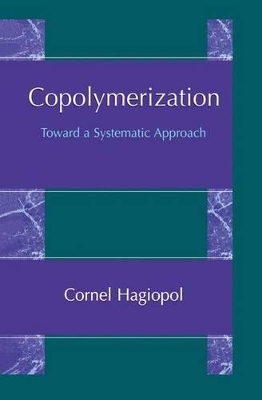
Copolymerization
Kluwer Academic/Plenum Publishers
978-0-306-46179-8 (ISBN)
- Titel z.Zt. nicht lieferbar
- Versandkostenfrei
- Auch auf Rechnung
- Artikel merken
1. Binary Copolymerization.- 1.1. Copolymers and Copolymerization Processes.- 1.2. The Terminal Kinetic Model: The Copolymer Composition Equation.- 1.3. Copolymerization Reaction Types.- 1.4. The Integral Form of the Copolymerization Equation.- 1.5. Use of the Differential and Integral Forms of the Mayo—Lewis Equation to Describe Copolymerization Processes.- 2. Estimation of Reactivity Ratios.- 2.1. Analysis of Experimental Data.- 2.2. How Consistent Are Existing Reactivity Ratios?.- 2.3. Differential Methods for Calculating Reactivity Ratios.- 2.4. Preliminary Remarks on an Experimental Strategy for Estimating Reactivity Ratios.- 2.5. Shortcomings of Differential Methods when Conversion Is Taken into Account.- 2.6. Estimation of Reactivity Ratios when Conversion Values Are Taken into Account.- 2.7. The Use of Composition versus Conversion Data in Estimating Reactivity Ratios.- 2.8. Recalculated Values for Reactivity Ratios.- 2.9. Experimental Errors and Effectiveness of theQ—eScheme.- 3. Ternary Copolymerization.- 3.1. The Terminal Kinetic Model: The Alfrey—Goldfinger Equation..- 3.2. Estimation of Reactivity Ratios Directly from Ternary Copolymerization Data.- 3.3. Azeotropy with Ternary Copolymerization.- 3.4. Consistency of Reactivity Ratio Values Used in Ternary Copolymerization.- 3.5. Do Ternary Azeotropes Exist? (Pseudoazeotropy).- 4. Going Beyond the Limits of the Terminal Model.- 4.1. The Extent to Which the Mayo—Lewis Equation Can Fit All Copolymerization Data.- 4.2. Higher Order Kinetic Models.- 4.3. The Potential of Experimental Composition Data.- 4.4. Optimal Experimental Design for Estimating Reactivity Ratios.- 4.5. Model Discrimination.- 4.6. Generalized Kinetic Model for Binary Copolymerization.- 5. Homogeneous and HeterogeneousCopolymerization.- 5.1. Copolymerization within Initially Homogeneous Systems.- 5.2. Emulsion Copolymerization.- 5.3. Copolymer Composition and the Mechanism of Emulsion Copolymerization.- 6. Running a Copolymerization Process.
| Erscheint lt. Verlag | 31.1.2000 |
|---|---|
| Zusatzinfo | XI, 228 p. With CD-ROM. |
| Sprache | englisch |
| Maße | 155 x 235 mm |
| Themenwelt | Mathematik / Informatik ► Informatik |
| Naturwissenschaften ► Chemie ► Organische Chemie | |
| Naturwissenschaften ► Chemie ► Physikalische Chemie | |
| Naturwissenschaften ► Chemie ► Technische Chemie | |
| Technik ► Maschinenbau | |
| ISBN-10 | 0-306-46179-X / 030646179X |
| ISBN-13 | 978-0-306-46179-8 / 9780306461798 |
| Zustand | Neuware |
| Haben Sie eine Frage zum Produkt? |
aus dem Bereich

![Organic Chemistry plus Pearson Mastering Chemistry with Pearson eText [Global Edition] - Leroy Wade; Jan Simek](/media/110496757)
